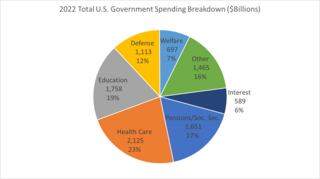Project management is the process of leading the work of a team to achieve all project goals within the given constraints. This information is usually described in project documentation, created at the beginning of the development process. The primary constraints are scope, time, and budget. The secondary challenge is to optimize the allocation of necessary inputs and apply them to meet pre-defined objectives.
The United States budget process is the framework used by Congress and the President of the United States to formulate and create the United States federal budget. The process was established by the Budget and Accounting Act of 1921, the Congressional Budget and Impoundment Control Act of 1974, and additional budget legislation.
A budget process refers to the process by which governments create and approve a budget, which is as follows:

The United States Department of State Bureau of Overseas Buildings Operations (OBO) is responsible for overseeing the construction, management, and operations of U.S. diplomatic facilities around the world.

The military budget of the United States is the largest portion of the discretionary federal budget allocated to the Department of Defense (DoD), or more broadly, the portion of the budget that goes to any military-related expenditures. The military budget pays the salaries, training, and health care of uniformed and civilian personnel, maintains arms, equipment and facilities, funds operations, and develops and buys new items. The budget funds five branches of the US military: the Army, Navy, Marine Corps, Air Force, and Space Force.

The United States budget comprises the spending and revenues of the U.S. federal government. The budget is the financial representation of the priorities of the government, reflecting historical debates and competing economic philosophies. The government primarily spends on healthcare, retirement, and defense programs. The non-partisan Congressional Budget Office provides extensive analysis of the budget and its economic effects. It has reported that large budget deficits over the next 30 years are projected to drive federal debt held by the public to unprecedented levels—from 98 percent of gross domestic product (GDP) in 2020 to 195 percent by 2050.
A government budget is a projection of the government's revenues and expenditure for a particular period of time often referred to as a financial or fiscal year, which may or may not correspond with the calendar year. Government revenues mostly include taxes while expenditures consist of government spending. A government budget is prepared by the government or other political entity. In most parliamentary systems, the budget is presented to the legislature and often requires approval of the legislature. Through this budget, the government implements economic policy and realizes its program priorities. Once the budget is approved, the use of funds from individual chapters is in the hands of government ministries and other institutions. Revenues of the state budget consist mainly of taxes, customs duties, fees and other revenues. State budget expenditures cover the activities of the state, which are either given by law or the constitution. The budget in itself does not appropriate funds for government programs, hence need for additional legislative measures. The word budget comes from the Old French bougette.
Performance-based budgeting is the practice of developing budgets based on the relationship between program funding levels and expected results from that program. The performance-based budgeting process is a tool that program administrators can use to manage more cost-efficient and effective budgeting outlays.

The under secretary of defense for intelligence and security or USD(I&S) is a high-ranking civilian position in the Office of the Secretary of Defense (OSD) within the U.S. Department of Defense (DoD) that acts as the principal civilian advisor and deputy to the secretary of defense (SecDef) and deputy secretary of defense (DepSecDef) on matters relating to military intelligence and security. The under secretary is appointed as a civilian by the president and confirmed by the Senate to serve at the pleasure of the president.

The under secretary of defense for personnel and readiness, or USD (P&R) is a high-ranking civilian position in the Office of the Secretary of Defense (OSD) within the United States Department of Defense responsible for advising the secretary and deputy secretary of defense on recruitment, career development, pay and benefits, and oversight of the state of military readiness. The under secretary is appointed from civilian life by the president and confirmed by the Senate to serve at the pleasure of the President.
Program budgeting or programme budgeting, developed by U.S. president Lyndon Johnson, is the budgeting system that, contrary to conventional budgeting, describes and gives the detailed costs of every activity or program that is to be carried out with a given budget. For example, expected results in a proposed program are described fully, along with its necessary resource, raw materials, equipment, and staff costs. The sum of all activities or program constitute the Program Budget. Thus, when looking at a Program Budget, one can easily find out what precisely will be carried out, at what cost and with what expected results in considerable detail.

Located at Kirtland Air Force Base, New Mexico, the Air Force Operational Test and Evaluation Center is a direct reporting unit of Headquarters, United States Air Force. It is the Air Force independent test agency responsible for testing, under operationally realistic conditions, new systems being developed for Air Force and multi-service use.
The Government Performance and Results Act of 1993 (GPRA) is a United States law enacted in 1993, one of a series of laws designed to improve government performance management. The GPRA requires agencies to engage in performance management tasks such as setting goals, measuring results, and reporting their progress. In order to comply with the GPRA, agencies produce strategic plans, performance plans, and conduct gap analyses of projects. The GPRA of 1993 established project planning, strategic planning, and set up a framework of reporting for agencies to show the progress they make towards achieving their goals.

The Business Transformation Agency (BTA) was an organization of the United States Department of Defense responsible for guiding the department's business operations modernization. The BTA was active from 2005 until its closure in 2011.

The under secretary of defense (comptroller)/chief financial officer, abbreviated USD(C)/CFO, is a high level civilian official in the United States Department of Defense. The Under Secretary of Defense (Comptroller) is the principal staff assistant and adviser to both the Secretary of Defense and the Deputy Secretary of Defense for all budgetary and fiscal matters, including the development and execution of the Defense Department's annual budget.

Robert F. Hale was the United States Under Secretary of Defense (Comptroller) from 2009 until 2014 and before that the Comptroller and Assistant Secretary of the Air Force for Financial Management. Hale has over thirty years of experience as a professional financial manager serving in a wide range of national defense related roles. In addition to his most recent position as Under Secretary of Defense and his previous appointment as Assistant Secretary of the Air Force, Hale has also served in the National Security Division of the Congressional Budget Office and as Executive Director of the American Society of Military Comptrollers. Hale is a fellow of the National Academy of Public Administration and a former member of the Defense Business Board. He was appointed to the National Commission on the Future of the Army by Representative Adam Smith (D-WA).
Public budgeting is a field of public administration and a discipline in the academic study of public administration. Budgeting is characterized by its approaches, functions, formation, and type.

The Federal Information Technology Acquisition Reform Act made changes to the ways the U.S. federal government buys and manages computer technology. It became law as a part of the National Defense Authorization Act for Fiscal Year 2015 (Title VIII, Subtitle D, H.R. 3979.

The Intelligence Authorization Act for Fiscal Year 2014 is a U.S. public law that authorizes appropriations for fiscal year 2014 for intelligence activities of the U.S. government. The law authorizes there to be funding for intelligence agencies such as the Central Intelligence Agency or the National Security Agency, but a separate appropriations bill would also have to pass in order for those agencies to receive any money.

Government spending in the United States is the spending of the federal government of the United States and the spending of its state and local governments.









